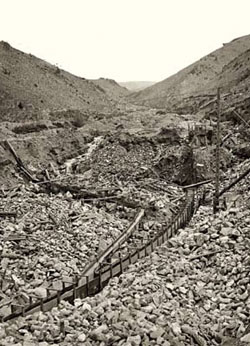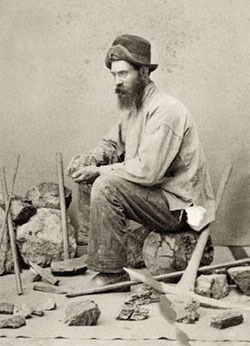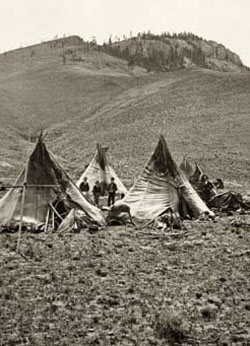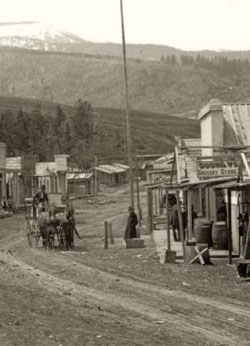Montana: Stories of the Land
Companion Website and Online Teacher's Guide
Chapter 6 - Montana's Gold and Silver Boom, 1862-1893
Chapter 1 - Montana: Where the Land Writes History
Chapter 2 - People of the Dog Days
Chapter 3 - From Dog Days to Horse Warriors
Chapter 4 - Newcomers Explore the Region
Chapter 5 - Beaver, Bison, and Black Robes
Chapter 6 - Montana's Gold and Silver Boom
Chapter 7 - Two Worlds Collide
Chapter 8 - Livestock and the Open Range
Chapter 9 - Railroads Link Montana to the Nation
Chapter 10 - Politics and the Copper Kings
Chapter 11 - The Early Reservation Years
Chapter 12 - Logging in the "High Lonesome"
Chapter 13 - Homesteading This Dry Land
Chapter 14 - Towns Have Lives, Too
Chapter 15 - Progressive Montana
Chapter 16 - Montana and World War I
Chapter 17 - Montanans on the Move
Chapter 18 - The Great Depression Transforms Montana
Chapter 19 - World War II in Montana
Chapter 20 - Building a New Montana
Chapter 21 - A People's Constitution
Chapter 22 - Living in a New Montana
Educator Resources
Educational Trunks
-
Gold Silver and Coal Oh My!: Mining Montana's Wealth from the Montana Historical Society. This trunk chronicles the discoveries that drew people to Montana in the late nineteenth century and examines how the mining industry developed and declined. Take a seven-minute video tour of some of the objects in the trunk.
-
East Meets West: The Chinese Experience in Montana from the Montana Historical Society. This trunk chronicles the lives of the Chinese who came to Montana, the customs that they brought with them to America, how they contributed to Montana communities, and why they left.
-
Getting the Gold from Montana Fish, Wildlife and Parks. These trunks cover hard rock and placer mining through activities and artifacts depicting the gold mining history in Bannack. (Scroll down and select "Traveling Trunks" to learn more.)
Takeaways
-
Inspired by reading specialist Tammy Elser, who was in turn inspired by SKC graduate Taylor Crawford, we've created a "Takeaway" bookmark for every chapter of Montana: Stories of the Land. Before starting a chapter, print and cut out these bookmarks and distribute them to your students. Ask them to use the Takeaway to summarize the GIST of what they learn from reading assigned sections of the chapter. Remind them that they don't have much room, so they'll need to think before they write down the most important idea they want to take away from the section. Learn a little more about the GIST strategy.
-
Even though we've created Takeaways for every chapter, we don't recommend you have your students complete a Takeaway for every section of every chapter they read. That would be exceedingly tedious. However, used appropriately, they can be a useful tool for encouraging reflection and teaching students how to summarize information.
Websites and Online Lesson Plans
-
The Annotated Resource Set “Montana’s Gold and Silver Boom, 1862-1893 includes links to photographs, maps, illustrations, and documents relating to Montana’s early mining history. Many, but not all, of the images were also used to illustrate Chapter 6 of Montana: Stories of the Land. These sources can be used to build PowerPoints or to create DBQs or other primary-source based activities.
-
Girl from the Gulches: The Story of Mary Ronan is a highly a readable memoir that details Mary Sheehan Ronan’s journey across the Great Plains, her childhood on the Montana mining frontier, as well as her later life on the Flathead Reservation as the wife of Indian Agent Peter Ronan. The Girl from the Gulches Study Guide includes lesson plans, vocabulary, chapter summaries and questions, alignment to the Common Core, and other information to facilitate this book's use in the classroom. Book One, which contains Mary's memories about Bannack, Virginia City, and Helena, is available to download as a PDF.
-
Created by Billings elementary school librarian Ruth Chandler Ferris, "Thinking Like a Historian: Using Digital Newspapers in the Classroom" is a flexible lesson plan that introduces students to newspaper research and the social history of gold-rush era Montana.
-
Historian Ellen Baumler has created a lesson plan, "Children of the Mining Camps," to accompany this PowerPoint presentation of the same title.
-
Ellen Baumler has also created a PowerPoint lesson called "What Would You Bring? Emigrant Families on Montana's Gold Rush Frontier." Accompanying a PowerPoint presentation by the same title, the lesson focuses on what life was like (especially for women and children) in early mining camps by looking at the objects brought by the Butts family to Helena in 1865 and displayed today in Helena's Pioneer Cabin.
-
Find a lesson plan that involves panning for gold on page 35 of the user guide for the "Gold, Silver and Coal" footlocker.
-
Montana: The Magazine of Western History created discussion guides for articles in its autumn 1999 gold rush issue, including "No Need to Rush: The Chinese, Placer Mining, and the Western Environment," by Liping Zhu. It also created discussion guides for articles in its winter 1999 transportation issue, including "The Steamboat and Stagecoach Era in Montana and the Northwest," by Carlos Schwantes. In both cases, the articles' full text (but not the pictures) are posted online.
-
Montana PBS created several lessons, designed to accompany the television series Frontier House, a reality television show that brought modern families to Nevada City, Montana, to simulate life on a nineteenth-century homestead. The lesson plans focus on westward migration, homesteading, and daily life in the 1880s for white settlers on the frontier.
-
"German Gulch" is a new website focused on the archaeological finds from German Gulch, a 19th and early 20th century mining area near Butte, Montana. The collection contains some of the most significant Chinese artifacts recovered in Montana.
Videos or DVDs
- Mining in Montana with Ellen Baumler - 6 minutes
- The Bozeman Trail: A Rush to Montana's Gold, Wyoming PBS-1 hour 27 minutes. Available at WyomingPBS and on YouTube.
-
From the Far East to the Old West: Chinese and Japanese Settlers in Montana, Mansfield Center for Pacific Affairs - 29 minutes. (Check your library. Copies of the video and study guide were distributed free of charge to all Montana public schools.)
- Pauper's Dream: Tribute to the Montana Hard Rock Miner, Joseph Campanella - 58 minutes. Buy the DVD or view on YouTube.
Possible Field Trips: View the Map
-
Bannack State Park, 24 miles southwest of Dillon
-
World Museum of Mining, Butte
-
Elkhorn State Park, near Boulder (Gravel road and high elevation make Elkhorn difficult to access in the winter.)
-
Garnet, 30 miles east of Missoula
-
Granite State Park, near Philipsburg (Accessing this ghost town requires high clearance vehicles.)
-
Helena (Use the booklet Camp to Capital: Step into Helena's Past, by Ellen Baumler et al, for a self-guided tour or download the free walking tour app at the App Store or Google Play.
-
Virginia City, Montana
Chapter 6 Test and Answer Keys Page
The tests and answer keys are password protected.
You can contact us to receive the password:
- Martha Kohl - call (406) 444-4790 or email mkohl@mt.gov
- Melissa Hibbard - call (406) 444-4741 or email Melissa.Hibbard@mt.gov
Or, if you used the old system, the original username is now the new password. You will be asked for this case-sensitive password every time you open a new document.
Alignment to ELA Common Core Standards
Alignment to Content Standards and Essential Understandings Regarding Montana Indians (EU)




